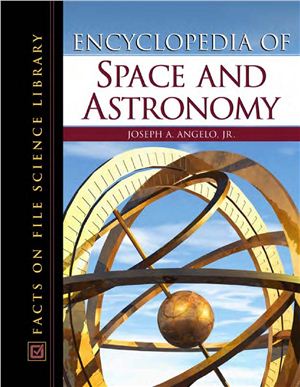Facts On File, 2006. 753 p. ISBN:10:0-8160-5330-8 (На английском
языке)
Солидная энциклопедия космонавтики и астрономии, ориентированная на массового читателя. Около 3 тысяч статей, расположенных в алфавитном порядке. Приложения содержат библиографию печатных ресурсов, длинную хронологию значительных событий в астрономии и космонавтике и 13-страничную таблицу с названиями планет, лун, астероидов, комет и других небесных тел. 200 чёрно-белых иллюстраций и фотографий.
Space, the final frontier, has piqued the imagination of people for millennia. Written by the author of several other books on space and astronomy at a level accessible to the general reader, this one-volume encyclopedia provides current, authoritative information. The approximately 3,000 alphabetically arranged entries range in length from a single sentence to several pages. Sample entries include Alvarez, Luis Walter; Apollo Project; Astrochimp(s); Big bang (theory); Collins, Eileen Marie; Copeicus, Nicholas; Cosmology; Extraterrestrial civilizations; National Solar Observatory; Radio astronomy; Robotics in space; Rocketry; Sun; Unidentified flying object (UFO); and Voyager spacecraft. Fifteen special essays cover topics beyond the nuts and bolts. We lea that, just like the poets have proclaimed, we really are made of stardust; Walt Disney popularized the idea of space travel; satellites function as switchboards in the sky; and people of the Earth have unintentionally been leaking radio frequency signals into the galaxy since the middle of the twentieth century.
Appendixes include a bibliography of print resources, an extensive listing of Web sites, a lengthy chronology of significant events in space and astronomy, a table of basic planetary data, and a 13-page table on how planets, moons, asteroids, comets, and other celestial objects are named. A well-constructed index provides subject access to the contents. About 200 black-and-white line illustrations and photographs supplement the text.
This work provides more in-depth coverage of topics than the Firefly Encyclopedia of Astronomy (2004), although the Firefly volume uses color illustrations and photographs to supplement the text and therefore has more visual appeal. The four-volume Encyclopedia of Astronomy and Astrophysics (Institute of Physics, 2001), written for an academic and professional audience, is a far more comprehensive (and therefore more expensive) set and is particularly suited for academic and large public libraries. The Facts On File encyclopedia is recommended for libraries in need of a general encyclopedia on space and astronomy.
Солидная энциклопедия космонавтики и астрономии, ориентированная на массового читателя. Около 3 тысяч статей, расположенных в алфавитном порядке. Приложения содержат библиографию печатных ресурсов, длинную хронологию значительных событий в астрономии и космонавтике и 13-страничную таблицу с названиями планет, лун, астероидов, комет и других небесных тел. 200 чёрно-белых иллюстраций и фотографий.
Space, the final frontier, has piqued the imagination of people for millennia. Written by the author of several other books on space and astronomy at a level accessible to the general reader, this one-volume encyclopedia provides current, authoritative information. The approximately 3,000 alphabetically arranged entries range in length from a single sentence to several pages. Sample entries include Alvarez, Luis Walter; Apollo Project; Astrochimp(s); Big bang (theory); Collins, Eileen Marie; Copeicus, Nicholas; Cosmology; Extraterrestrial civilizations; National Solar Observatory; Radio astronomy; Robotics in space; Rocketry; Sun; Unidentified flying object (UFO); and Voyager spacecraft. Fifteen special essays cover topics beyond the nuts and bolts. We lea that, just like the poets have proclaimed, we really are made of stardust; Walt Disney popularized the idea of space travel; satellites function as switchboards in the sky; and people of the Earth have unintentionally been leaking radio frequency signals into the galaxy since the middle of the twentieth century.
Appendixes include a bibliography of print resources, an extensive listing of Web sites, a lengthy chronology of significant events in space and astronomy, a table of basic planetary data, and a 13-page table on how planets, moons, asteroids, comets, and other celestial objects are named. A well-constructed index provides subject access to the contents. About 200 black-and-white line illustrations and photographs supplement the text.
This work provides more in-depth coverage of topics than the Firefly Encyclopedia of Astronomy (2004), although the Firefly volume uses color illustrations and photographs to supplement the text and therefore has more visual appeal. The four-volume Encyclopedia of Astronomy and Astrophysics (Institute of Physics, 2001), written for an academic and professional audience, is a far more comprehensive (and therefore more expensive) set and is particularly suited for academic and large public libraries. The Facts On File encyclopedia is recommended for libraries in need of a general encyclopedia on space and astronomy.

